McDonald's Business Environment: Internal & External Analysis
VerifiedAdded on 2024/06/05
|19
|4480
|372
Report
AI Summary
This report provides a comprehensive analysis of the business environment affecting McDonald's, a leading fast-food company. It explores different types of organizations, including public, private, and voluntary sectors, and their legal structures, highlighting McDonald's corporate structure. The report examines the interrelationship of various functions within an organization, such as production, finance, HRM, and marketing, and how they link to organizational objectives and structure. It also identifies the positive and negative impacts of the macro environment on McDonald's business operations, using contemporary examples. Furthermore, the report delves into the internal strengths and weaknesses of McDonald's and explains their interrelationship with external macro factors, conducting both internal and external analyses to identify these strengths and weaknesses and how they interact with the broader environment. The report concludes by summarizing the key findings and their implications for McDonald's business strategy.
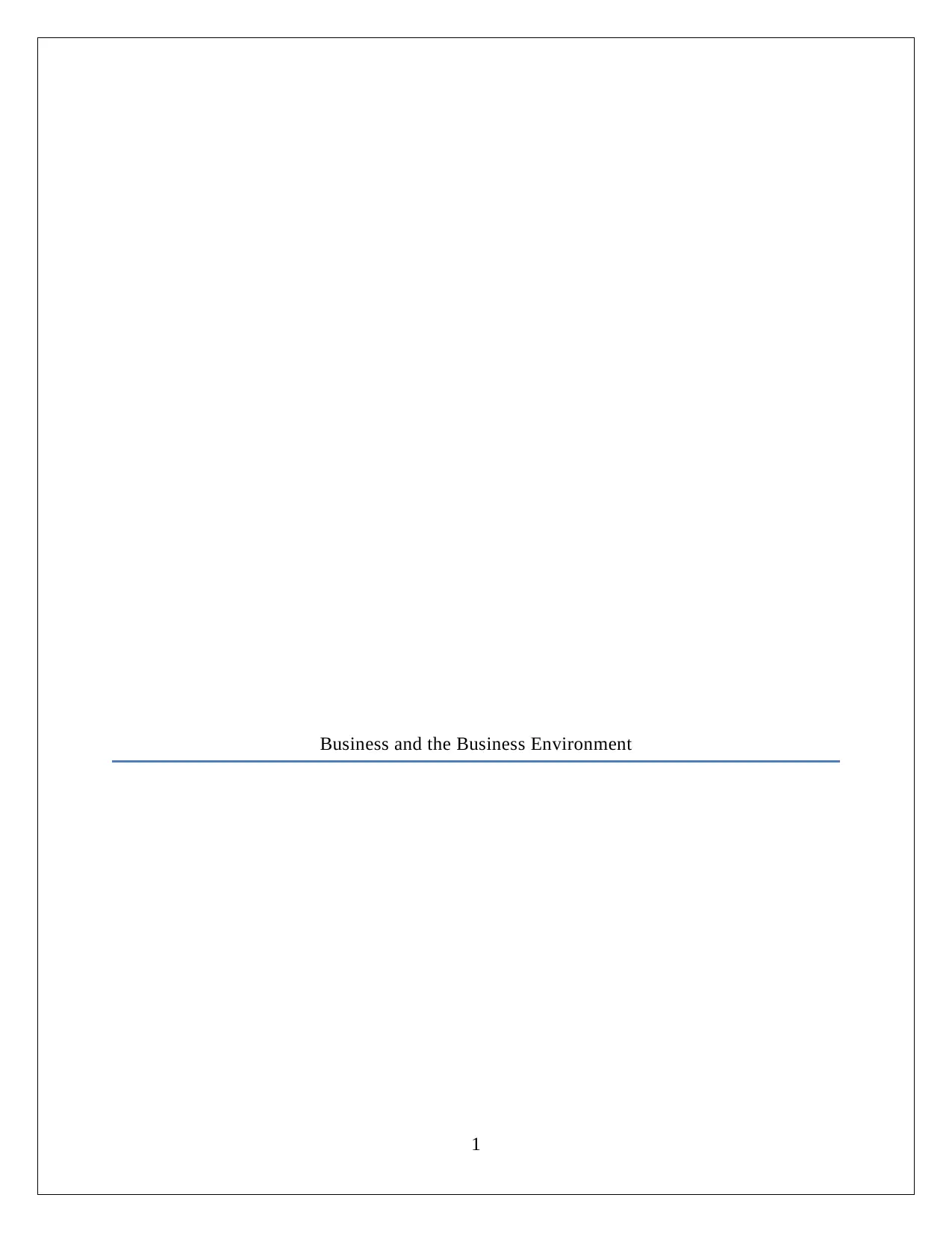
Business and the Business Environment
1
1
Paraphrase This Document
Need a fresh take? Get an instant paraphrase of this document with our AI Paraphraser
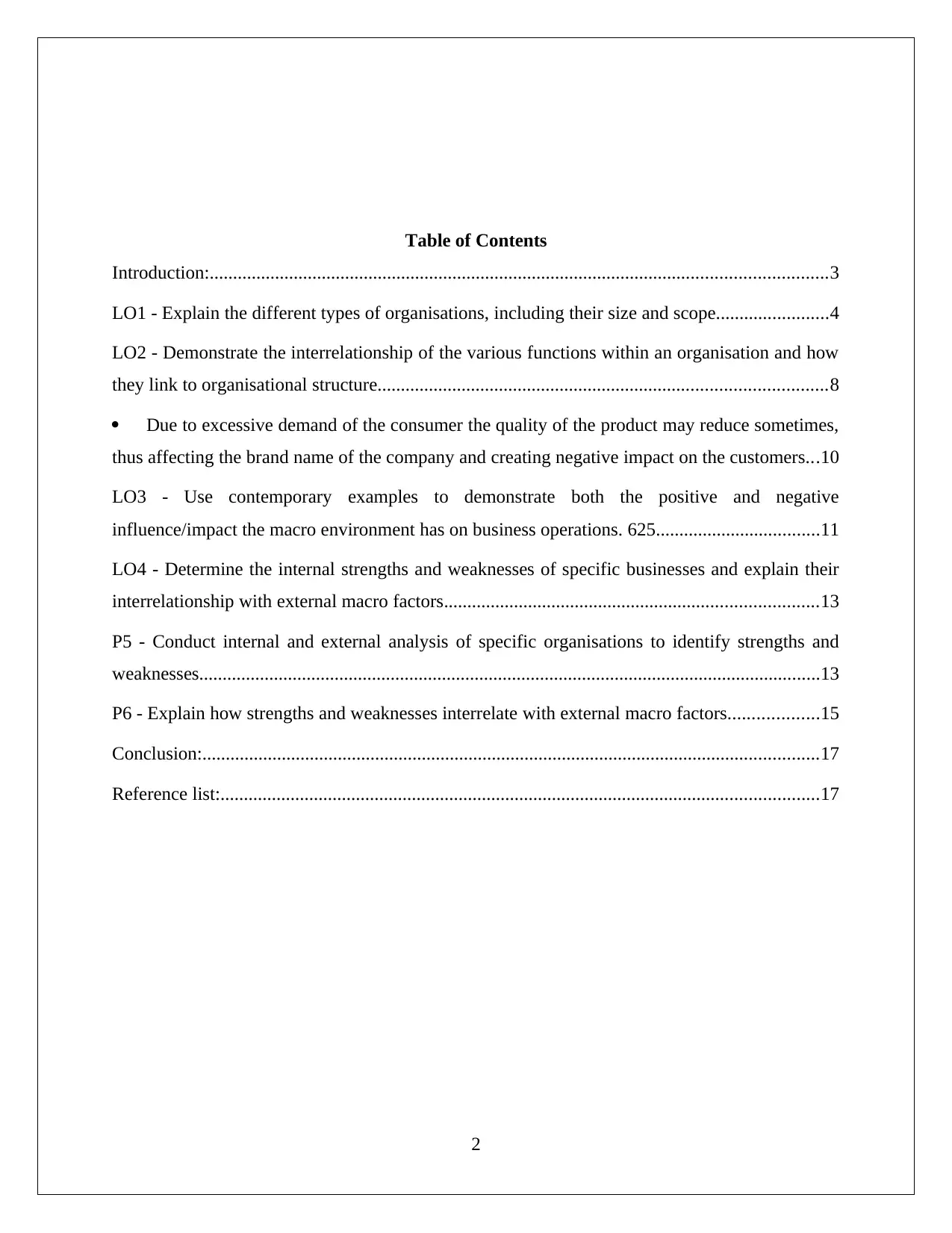
Table of Contents
Introduction:....................................................................................................................................3
LO1 - Explain the different types of organisations, including their size and scope........................4
LO2 - Demonstrate the interrelationship of the various functions within an organisation and how
they link to organisational structure................................................................................................8
Due to excessive demand of the consumer the quality of the product may reduce sometimes,
thus affecting the brand name of the company and creating negative impact on the customers...10
LO3 - Use contemporary examples to demonstrate both the positive and negative
influence/impact the macro environment has on business operations. 625...................................11
LO4 - Determine the internal strengths and weaknesses of specific businesses and explain their
interrelationship with external macro factors................................................................................13
P5 - Conduct internal and external analysis of specific organisations to identify strengths and
weaknesses.....................................................................................................................................13
P6 - Explain how strengths and weaknesses interrelate with external macro factors...................15
Conclusion:....................................................................................................................................17
Reference list:................................................................................................................................17
2
Introduction:....................................................................................................................................3
LO1 - Explain the different types of organisations, including their size and scope........................4
LO2 - Demonstrate the interrelationship of the various functions within an organisation and how
they link to organisational structure................................................................................................8
Due to excessive demand of the consumer the quality of the product may reduce sometimes,
thus affecting the brand name of the company and creating negative impact on the customers...10
LO3 - Use contemporary examples to demonstrate both the positive and negative
influence/impact the macro environment has on business operations. 625...................................11
LO4 - Determine the internal strengths and weaknesses of specific businesses and explain their
interrelationship with external macro factors................................................................................13
P5 - Conduct internal and external analysis of specific organisations to identify strengths and
weaknesses.....................................................................................................................................13
P6 - Explain how strengths and weaknesses interrelate with external macro factors...................15
Conclusion:....................................................................................................................................17
Reference list:................................................................................................................................17
2
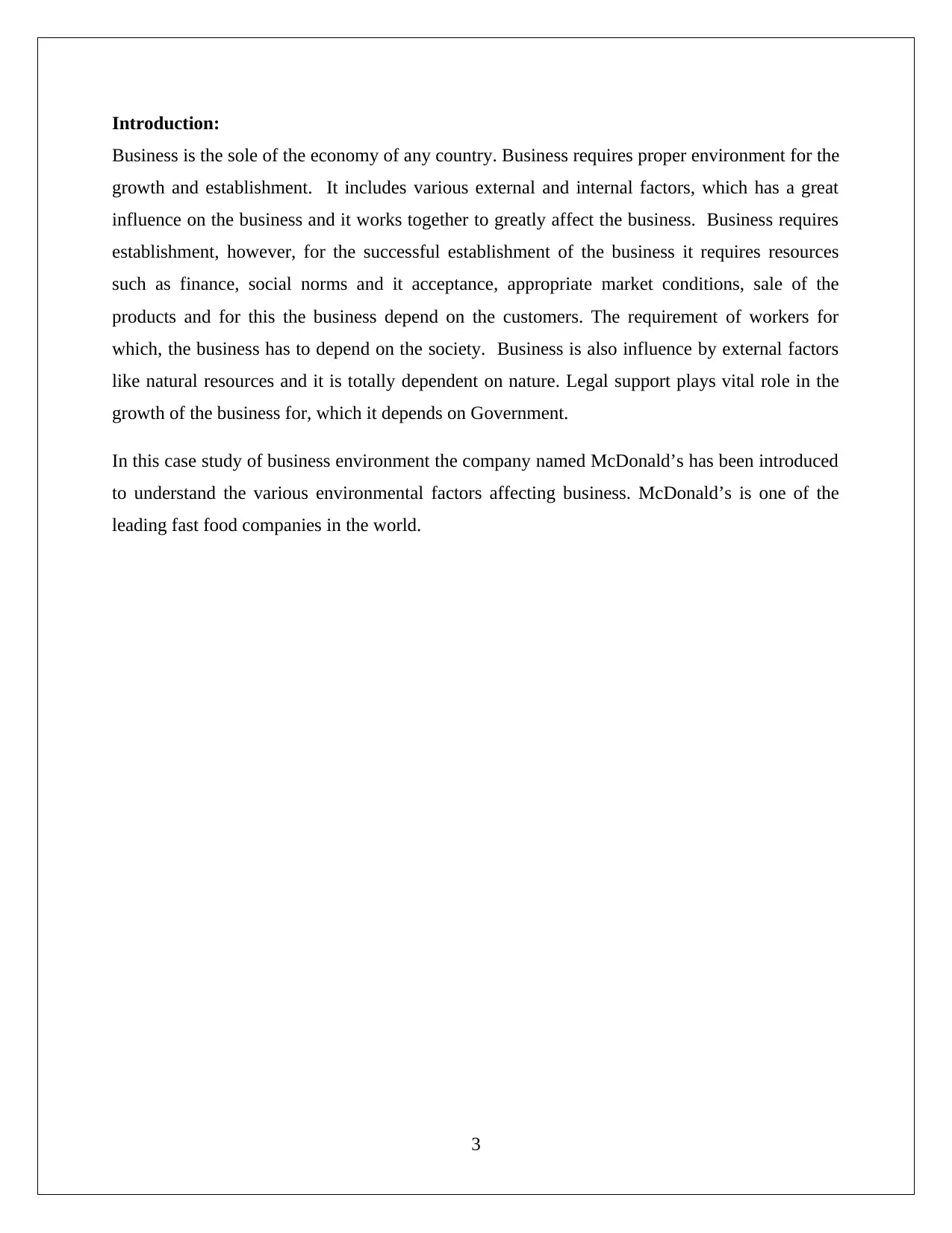
Introduction:
Business is the sole of the economy of any country. Business requires proper environment for the
growth and establishment. It includes various external and internal factors, which has a great
influence on the business and it works together to greatly affect the business. Business requires
establishment, however, for the successful establishment of the business it requires resources
such as finance, social norms and it acceptance, appropriate market conditions, sale of the
products and for this the business depend on the customers. The requirement of workers for
which, the business has to depend on the society. Business is also influence by external factors
like natural resources and it is totally dependent on nature. Legal support plays vital role in the
growth of the business for, which it depends on Government.
In this case study of business environment the company named McDonald’s has been introduced
to understand the various environmental factors affecting business. McDonald’s is one of the
leading fast food companies in the world.
3
Business is the sole of the economy of any country. Business requires proper environment for the
growth and establishment. It includes various external and internal factors, which has a great
influence on the business and it works together to greatly affect the business. Business requires
establishment, however, for the successful establishment of the business it requires resources
such as finance, social norms and it acceptance, appropriate market conditions, sale of the
products and for this the business depend on the customers. The requirement of workers for
which, the business has to depend on the society. Business is also influence by external factors
like natural resources and it is totally dependent on nature. Legal support plays vital role in the
growth of the business for, which it depends on Government.
In this case study of business environment the company named McDonald’s has been introduced
to understand the various environmental factors affecting business. McDonald’s is one of the
leading fast food companies in the world.
3
⊘ This is a preview!⊘
Do you want full access?
Subscribe today to unlock all pages.

Trusted by 1+ million students worldwide
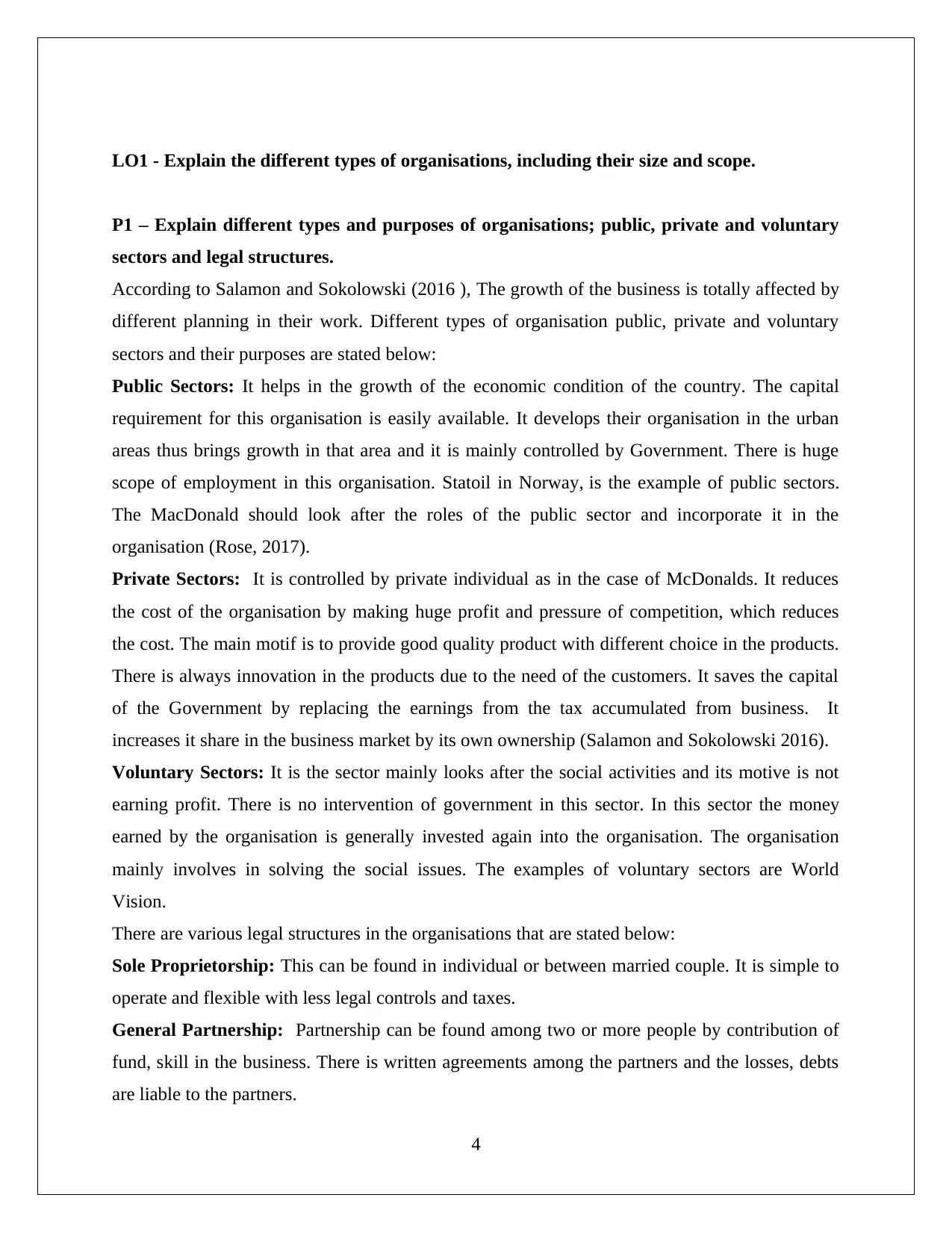
LO1 - Explain the different types of organisations, including their size and scope.
P1 – Explain different types and purposes of organisations; public, private and voluntary
sectors and legal structures.
According to Salamon and Sokolowski (2016 ), The growth of the business is totally affected by
different planning in their work. Different types of organisation public, private and voluntary
sectors and their purposes are stated below:
Public Sectors: It helps in the growth of the economic condition of the country. The capital
requirement for this organisation is easily available. It develops their organisation in the urban
areas thus brings growth in that area and it is mainly controlled by Government. There is huge
scope of employment in this organisation. Statoil in Norway, is the example of public sectors.
The MacDonald should look after the roles of the public sector and incorporate it in the
organisation (Rose, 2017).
Private Sectors: It is controlled by private individual as in the case of McDonalds. It reduces
the cost of the organisation by making huge profit and pressure of competition, which reduces
the cost. The main motif is to provide good quality product with different choice in the products.
There is always innovation in the products due to the need of the customers. It saves the capital
of the Government by replacing the earnings from the tax accumulated from business. It
increases it share in the business market by its own ownership (Salamon and Sokolowski 2016).
Voluntary Sectors: It is the sector mainly looks after the social activities and its motive is not
earning profit. There is no intervention of government in this sector. In this sector the money
earned by the organisation is generally invested again into the organisation. The organisation
mainly involves in solving the social issues. The examples of voluntary sectors are World
Vision.
There are various legal structures in the organisations that are stated below:
Sole Proprietorship: This can be found in individual or between married couple. It is simple to
operate and flexible with less legal controls and taxes.
General Partnership: Partnership can be found among two or more people by contribution of
fund, skill in the business. There is written agreements among the partners and the losses, debts
are liable to the partners.
4
P1 – Explain different types and purposes of organisations; public, private and voluntary
sectors and legal structures.
According to Salamon and Sokolowski (2016 ), The growth of the business is totally affected by
different planning in their work. Different types of organisation public, private and voluntary
sectors and their purposes are stated below:
Public Sectors: It helps in the growth of the economic condition of the country. The capital
requirement for this organisation is easily available. It develops their organisation in the urban
areas thus brings growth in that area and it is mainly controlled by Government. There is huge
scope of employment in this organisation. Statoil in Norway, is the example of public sectors.
The MacDonald should look after the roles of the public sector and incorporate it in the
organisation (Rose, 2017).
Private Sectors: It is controlled by private individual as in the case of McDonalds. It reduces
the cost of the organisation by making huge profit and pressure of competition, which reduces
the cost. The main motif is to provide good quality product with different choice in the products.
There is always innovation in the products due to the need of the customers. It saves the capital
of the Government by replacing the earnings from the tax accumulated from business. It
increases it share in the business market by its own ownership (Salamon and Sokolowski 2016).
Voluntary Sectors: It is the sector mainly looks after the social activities and its motive is not
earning profit. There is no intervention of government in this sector. In this sector the money
earned by the organisation is generally invested again into the organisation. The organisation
mainly involves in solving the social issues. The examples of voluntary sectors are World
Vision.
There are various legal structures in the organisations that are stated below:
Sole Proprietorship: This can be found in individual or between married couple. It is simple to
operate and flexible with less legal controls and taxes.
General Partnership: Partnership can be found among two or more people by contribution of
fund, skill in the business. There is written agreements among the partners and the losses, debts
are liable to the partners.
4
Paraphrase This Document
Need a fresh take? Get an instant paraphrase of this document with our AI Paraphraser
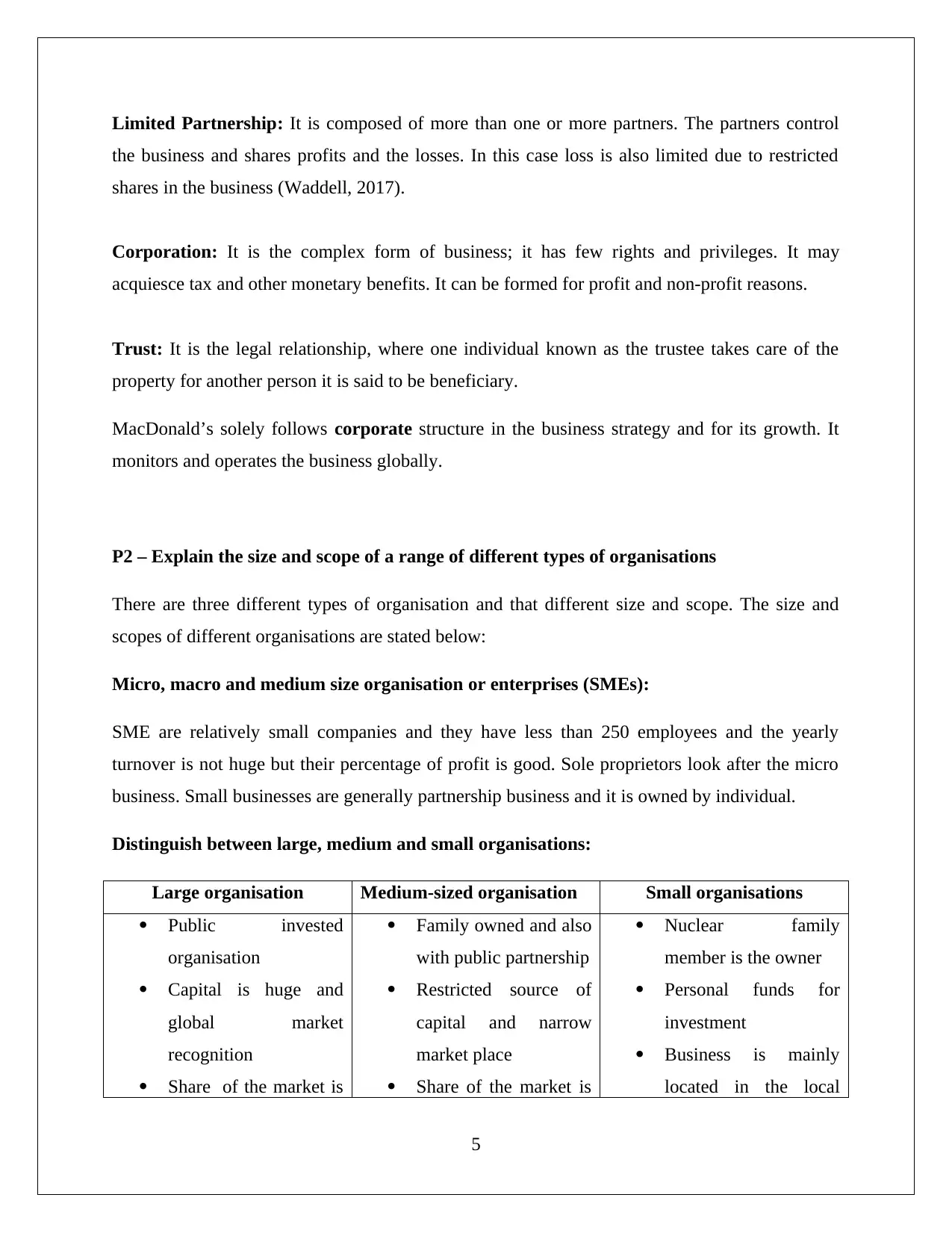
Limited Partnership: It is composed of more than one or more partners. The partners control
the business and shares profits and the losses. In this case loss is also limited due to restricted
shares in the business (Waddell, 2017).
Corporation: It is the complex form of business; it has few rights and privileges. It may
acquiesce tax and other monetary benefits. It can be formed for profit and non-profit reasons.
Trust: It is the legal relationship, where one individual known as the trustee takes care of the
property for another person it is said to be beneficiary.
MacDonald’s solely follows corporate structure in the business strategy and for its growth. It
monitors and operates the business globally.
P2 – Explain the size and scope of a range of different types of organisations
There are three different types of organisation and that different size and scope. The size and
scopes of different organisations are stated below:
Micro, macro and medium size organisation or enterprises (SMEs):
SME are relatively small companies and they have less than 250 employees and the yearly
turnover is not huge but their percentage of profit is good. Sole proprietors look after the micro
business. Small businesses are generally partnership business and it is owned by individual.
Distinguish between large, medium and small organisations:
Large organisation Medium-sized organisation Small organisations
Public invested
organisation
Capital is huge and
global market
recognition
Share of the market is
Family owned and also
with public partnership
Restricted source of
capital and narrow
market place
Share of the market is
Nuclear family
member is the owner
Personal funds for
investment
Business is mainly
located in the local
5
the business and shares profits and the losses. In this case loss is also limited due to restricted
shares in the business (Waddell, 2017).
Corporation: It is the complex form of business; it has few rights and privileges. It may
acquiesce tax and other monetary benefits. It can be formed for profit and non-profit reasons.
Trust: It is the legal relationship, where one individual known as the trustee takes care of the
property for another person it is said to be beneficiary.
MacDonald’s solely follows corporate structure in the business strategy and for its growth. It
monitors and operates the business globally.
P2 – Explain the size and scope of a range of different types of organisations
There are three different types of organisation and that different size and scope. The size and
scopes of different organisations are stated below:
Micro, macro and medium size organisation or enterprises (SMEs):
SME are relatively small companies and they have less than 250 employees and the yearly
turnover is not huge but their percentage of profit is good. Sole proprietors look after the micro
business. Small businesses are generally partnership business and it is owned by individual.
Distinguish between large, medium and small organisations:
Large organisation Medium-sized organisation Small organisations
Public invested
organisation
Capital is huge and
global market
recognition
Share of the market is
Family owned and also
with public partnership
Restricted source of
capital and narrow
market place
Share of the market is
Nuclear family
member is the owner
Personal funds for
investment
Business is mainly
located in the local
5
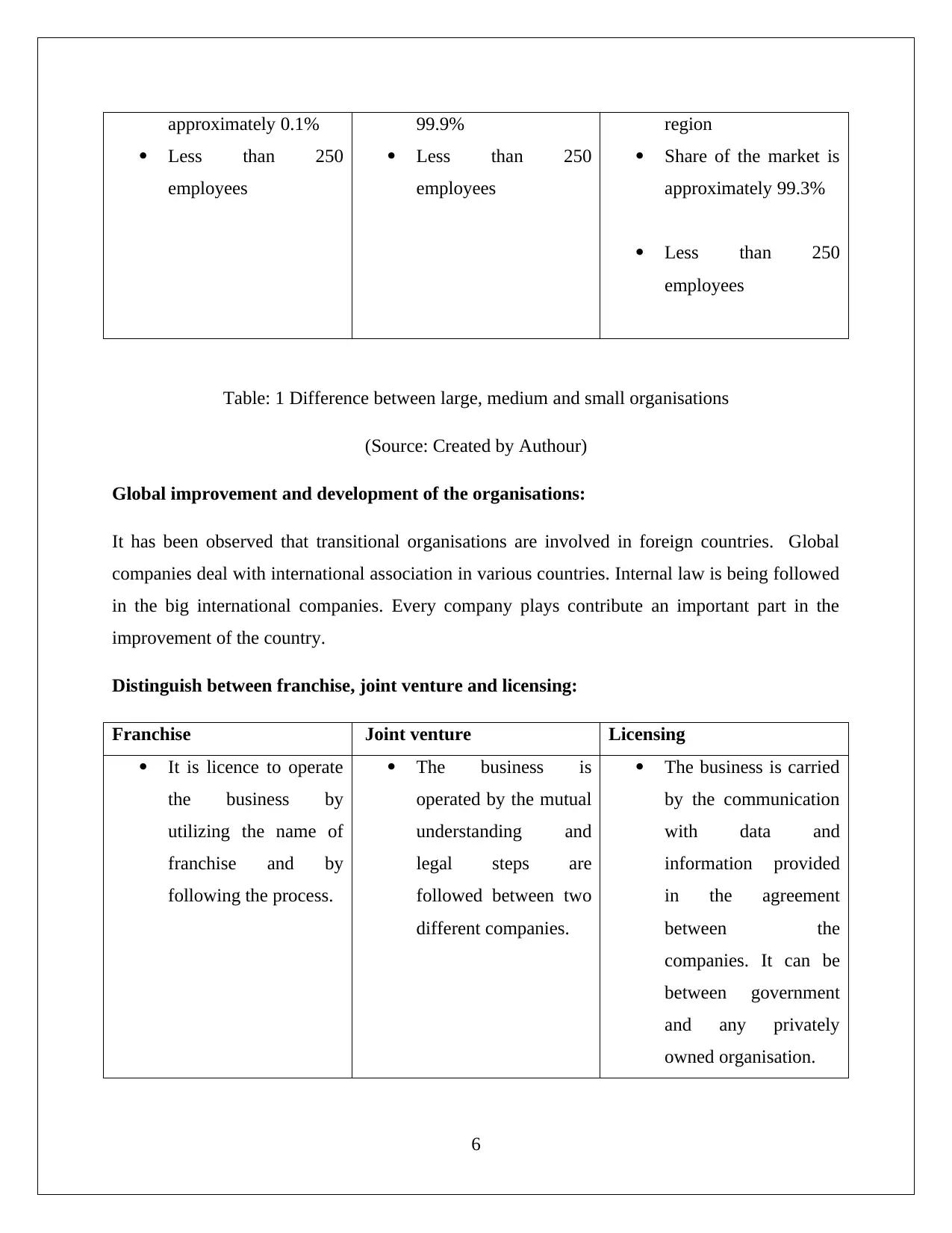
approximately 0.1%
Less than 250
employees
99.9%
Less than 250
employees
region
Share of the market is
approximately 99.3%
Less than 250
employees
Table: 1 Difference between large, medium and small organisations
(Source: Created by Authour)
Global improvement and development of the organisations:
It has been observed that transitional organisations are involved in foreign countries. Global
companies deal with international association in various countries. Internal law is being followed
in the big international companies. Every company plays contribute an important part in the
improvement of the country.
Distinguish between franchise, joint venture and licensing:
Franchise Joint venture Licensing
It is licence to operate
the business by
utilizing the name of
franchise and by
following the process.
The business is
operated by the mutual
understanding and
legal steps are
followed between two
different companies.
The business is carried
by the communication
with data and
information provided
in the agreement
between the
companies. It can be
between government
and any privately
owned organisation.
6
Less than 250
employees
99.9%
Less than 250
employees
region
Share of the market is
approximately 99.3%
Less than 250
employees
Table: 1 Difference between large, medium and small organisations
(Source: Created by Authour)
Global improvement and development of the organisations:
It has been observed that transitional organisations are involved in foreign countries. Global
companies deal with international association in various countries. Internal law is being followed
in the big international companies. Every company plays contribute an important part in the
improvement of the country.
Distinguish between franchise, joint venture and licensing:
Franchise Joint venture Licensing
It is licence to operate
the business by
utilizing the name of
franchise and by
following the process.
The business is
operated by the mutual
understanding and
legal steps are
followed between two
different companies.
The business is carried
by the communication
with data and
information provided
in the agreement
between the
companies. It can be
between government
and any privately
owned organisation.
6
⊘ This is a preview!⊘
Do you want full access?
Subscribe today to unlock all pages.

Trusted by 1+ million students worldwide
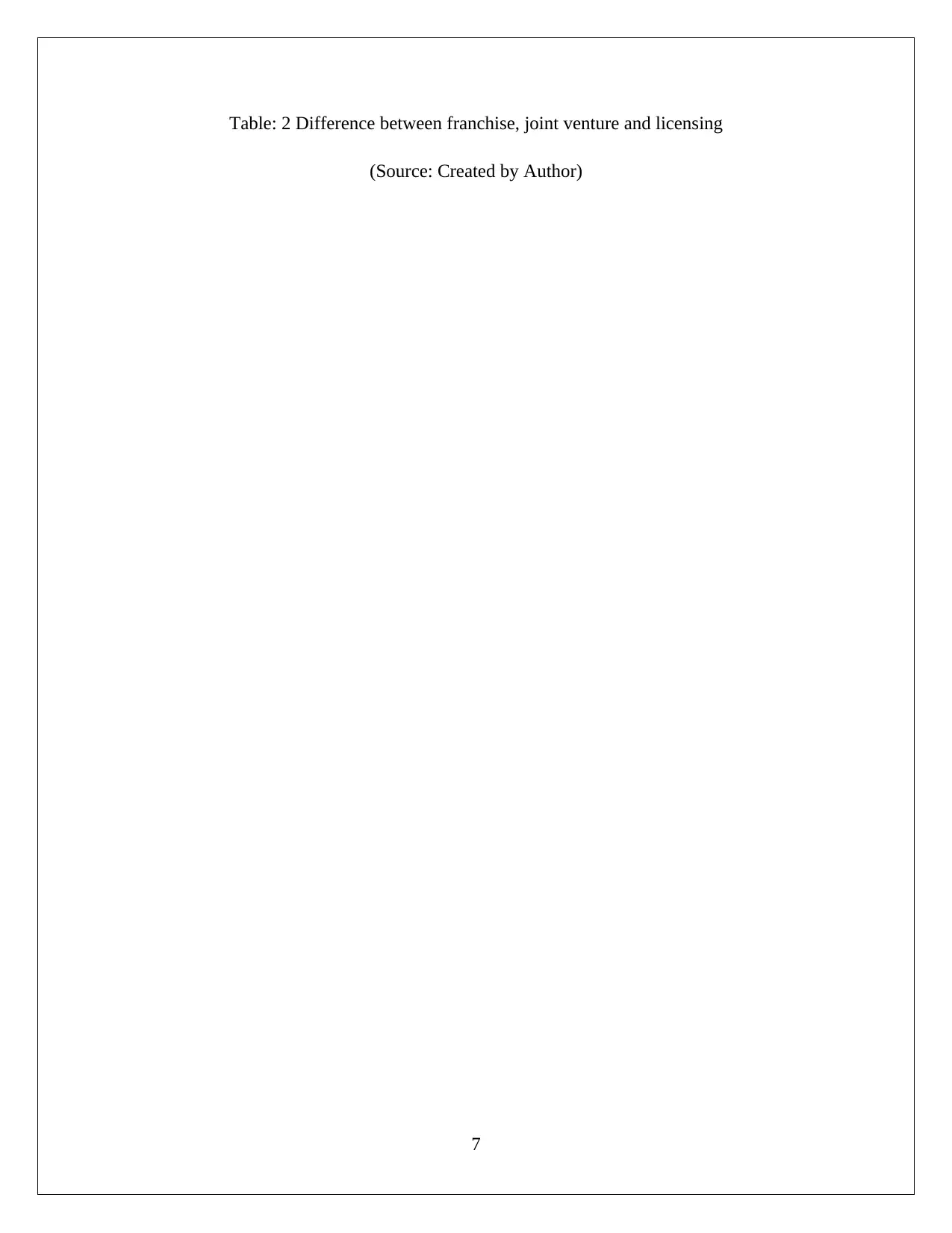
Table: 2 Difference between franchise, joint venture and licensing
(Source: Created by Author)
7
(Source: Created by Author)
7
Paraphrase This Document
Need a fresh take? Get an instant paraphrase of this document with our AI Paraphraser
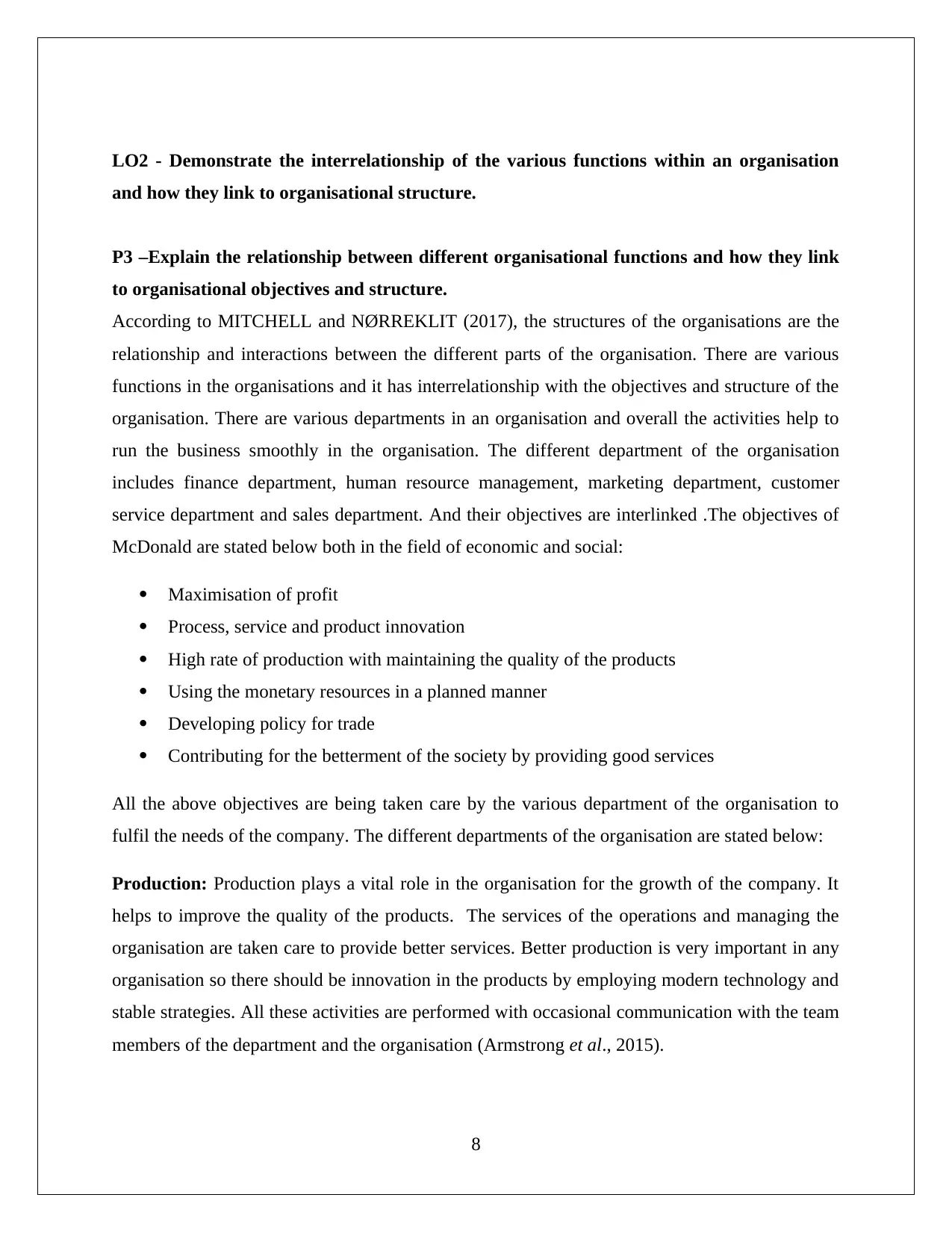
LO2 - Demonstrate the interrelationship of the various functions within an organisation
and how they link to organisational structure.
P3 –Explain the relationship between different organisational functions and how they link
to organisational objectives and structure.
According to MITCHELL and NØRREKLIT (2017), the structures of the organisations are the
relationship and interactions between the different parts of the organisation. There are various
functions in the organisations and it has interrelationship with the objectives and structure of the
organisation. There are various departments in an organisation and overall the activities help to
run the business smoothly in the organisation. The different department of the organisation
includes finance department, human resource management, marketing department, customer
service department and sales department. And their objectives are interlinked .The objectives of
McDonald are stated below both in the field of economic and social:
Maximisation of profit
Process, service and product innovation
High rate of production with maintaining the quality of the products
Using the monetary resources in a planned manner
Developing policy for trade
Contributing for the betterment of the society by providing good services
All the above objectives are being taken care by the various department of the organisation to
fulfil the needs of the company. The different departments of the organisation are stated below:
Production: Production plays a vital role in the organisation for the growth of the company. It
helps to improve the quality of the products. The services of the operations and managing the
organisation are taken care to provide better services. Better production is very important in any
organisation so there should be innovation in the products by employing modern technology and
stable strategies. All these activities are performed with occasional communication with the team
members of the department and the organisation (Armstrong et al., 2015).
8
and how they link to organisational structure.
P3 –Explain the relationship between different organisational functions and how they link
to organisational objectives and structure.
According to MITCHELL and NØRREKLIT (2017), the structures of the organisations are the
relationship and interactions between the different parts of the organisation. There are various
functions in the organisations and it has interrelationship with the objectives and structure of the
organisation. There are various departments in an organisation and overall the activities help to
run the business smoothly in the organisation. The different department of the organisation
includes finance department, human resource management, marketing department, customer
service department and sales department. And their objectives are interlinked .The objectives of
McDonald are stated below both in the field of economic and social:
Maximisation of profit
Process, service and product innovation
High rate of production with maintaining the quality of the products
Using the monetary resources in a planned manner
Developing policy for trade
Contributing for the betterment of the society by providing good services
All the above objectives are being taken care by the various department of the organisation to
fulfil the needs of the company. The different departments of the organisation are stated below:
Production: Production plays a vital role in the organisation for the growth of the company. It
helps to improve the quality of the products. The services of the operations and managing the
organisation are taken care to provide better services. Better production is very important in any
organisation so there should be innovation in the products by employing modern technology and
stable strategies. All these activities are performed with occasional communication with the team
members of the department and the organisation (Armstrong et al., 2015).
8
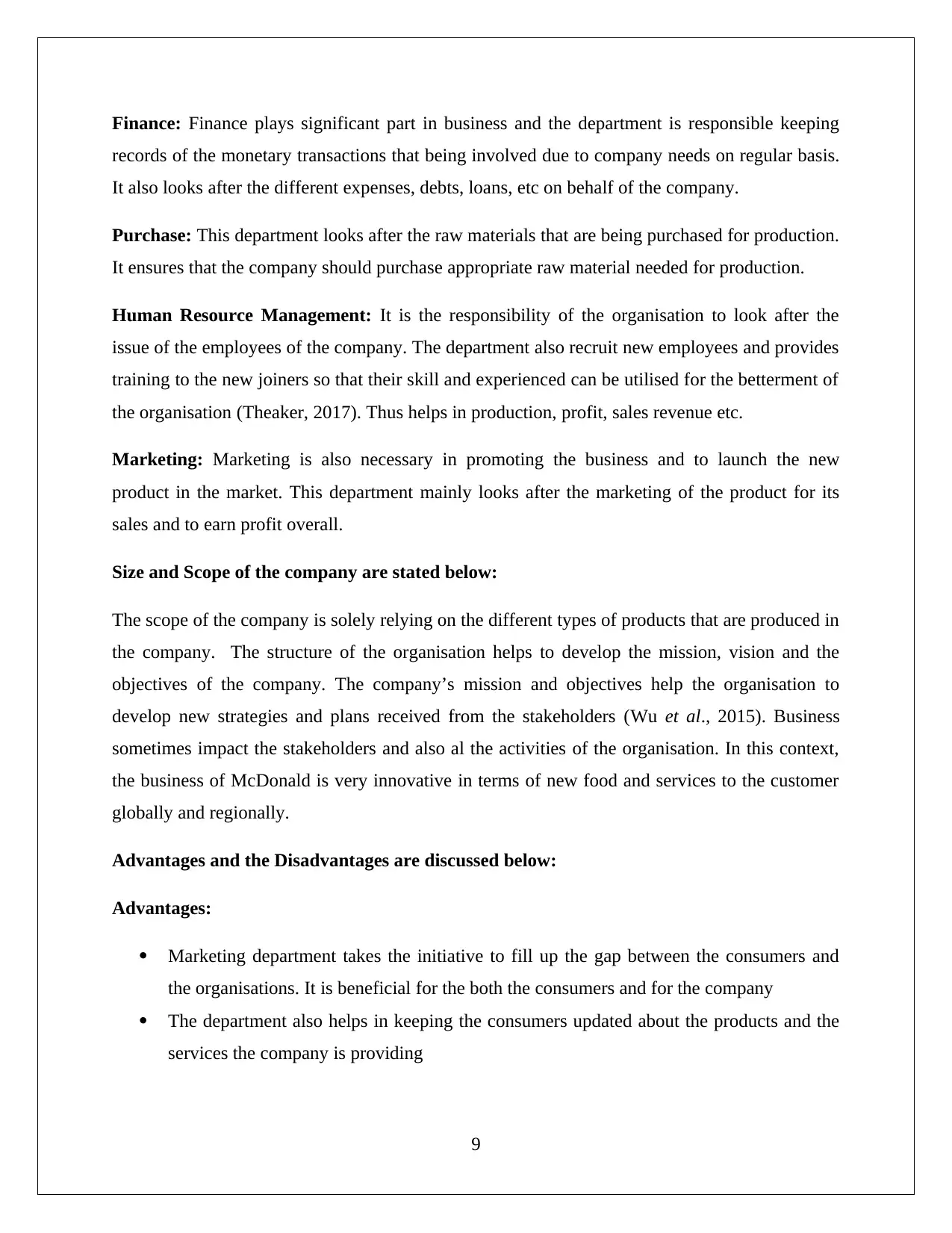
Finance: Finance plays significant part in business and the department is responsible keeping
records of the monetary transactions that being involved due to company needs on regular basis.
It also looks after the different expenses, debts, loans, etc on behalf of the company.
Purchase: This department looks after the raw materials that are being purchased for production.
It ensures that the company should purchase appropriate raw material needed for production.
Human Resource Management: It is the responsibility of the organisation to look after the
issue of the employees of the company. The department also recruit new employees and provides
training to the new joiners so that their skill and experienced can be utilised for the betterment of
the organisation (Theaker, 2017). Thus helps in production, profit, sales revenue etc.
Marketing: Marketing is also necessary in promoting the business and to launch the new
product in the market. This department mainly looks after the marketing of the product for its
sales and to earn profit overall.
Size and Scope of the company are stated below:
The scope of the company is solely relying on the different types of products that are produced in
the company. The structure of the organisation helps to develop the mission, vision and the
objectives of the company. The company’s mission and objectives help the organisation to
develop new strategies and plans received from the stakeholders (Wu et al., 2015). Business
sometimes impact the stakeholders and also al the activities of the organisation. In this context,
the business of McDonald is very innovative in terms of new food and services to the customer
globally and regionally.
Advantages and the Disadvantages are discussed below:
Advantages:
Marketing department takes the initiative to fill up the gap between the consumers and
the organisations. It is beneficial for the both the consumers and for the company
The department also helps in keeping the consumers updated about the products and the
services the company is providing
9
records of the monetary transactions that being involved due to company needs on regular basis.
It also looks after the different expenses, debts, loans, etc on behalf of the company.
Purchase: This department looks after the raw materials that are being purchased for production.
It ensures that the company should purchase appropriate raw material needed for production.
Human Resource Management: It is the responsibility of the organisation to look after the
issue of the employees of the company. The department also recruit new employees and provides
training to the new joiners so that their skill and experienced can be utilised for the betterment of
the organisation (Theaker, 2017). Thus helps in production, profit, sales revenue etc.
Marketing: Marketing is also necessary in promoting the business and to launch the new
product in the market. This department mainly looks after the marketing of the product for its
sales and to earn profit overall.
Size and Scope of the company are stated below:
The scope of the company is solely relying on the different types of products that are produced in
the company. The structure of the organisation helps to develop the mission, vision and the
objectives of the company. The company’s mission and objectives help the organisation to
develop new strategies and plans received from the stakeholders (Wu et al., 2015). Business
sometimes impact the stakeholders and also al the activities of the organisation. In this context,
the business of McDonald is very innovative in terms of new food and services to the customer
globally and regionally.
Advantages and the Disadvantages are discussed below:
Advantages:
Marketing department takes the initiative to fill up the gap between the consumers and
the organisations. It is beneficial for the both the consumers and for the company
The department also helps in keeping the consumers updated about the products and the
services the company is providing
9
⊘ This is a preview!⊘
Do you want full access?
Subscribe today to unlock all pages.

Trusted by 1+ million students worldwide
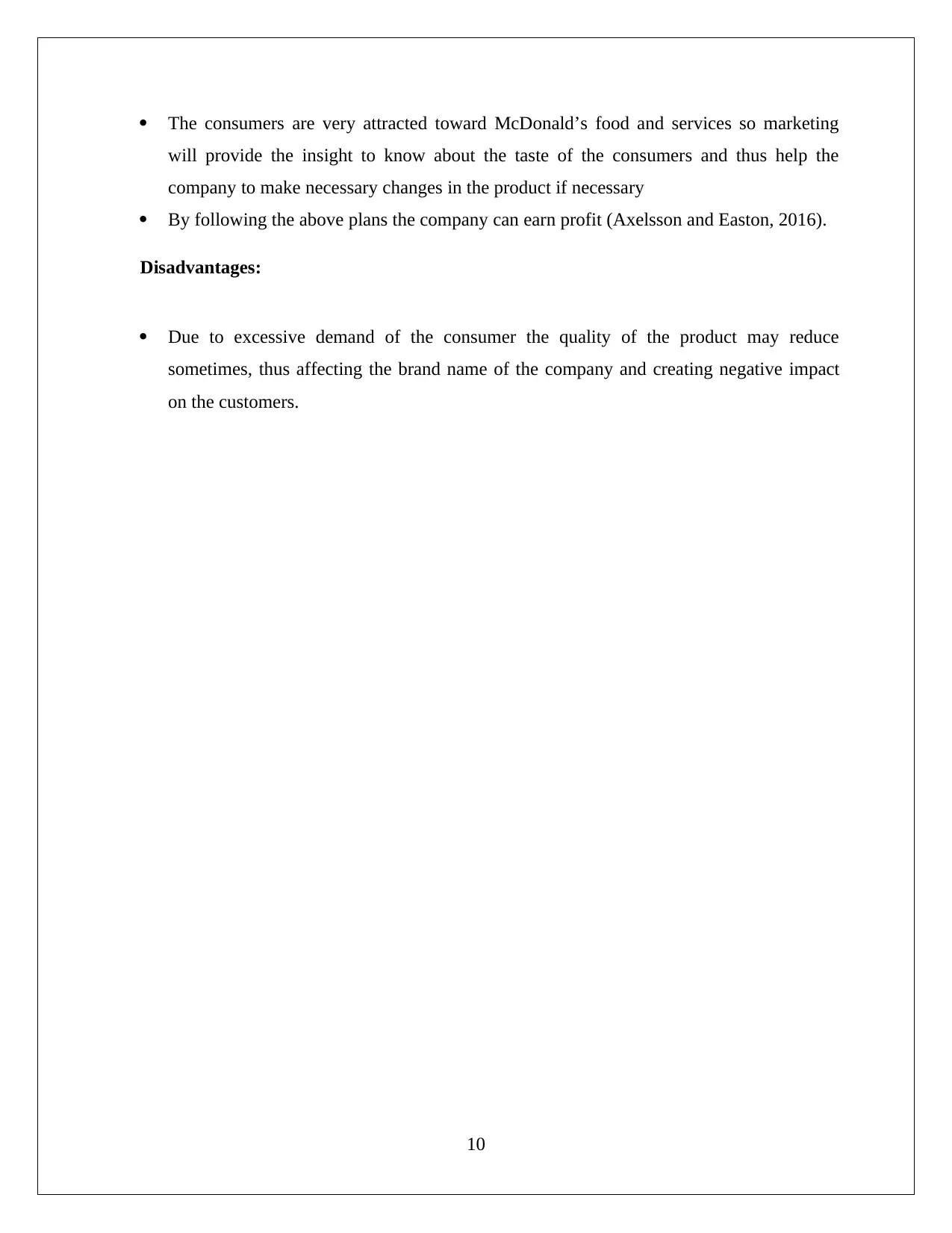
The consumers are very attracted toward McDonald’s food and services so marketing
will provide the insight to know about the taste of the consumers and thus help the
company to make necessary changes in the product if necessary
By following the above plans the company can earn profit (Axelsson and Easton, 2016).
Disadvantages:
Due to excessive demand of the consumer the quality of the product may reduce
sometimes, thus affecting the brand name of the company and creating negative impact
on the customers.
10
will provide the insight to know about the taste of the consumers and thus help the
company to make necessary changes in the product if necessary
By following the above plans the company can earn profit (Axelsson and Easton, 2016).
Disadvantages:
Due to excessive demand of the consumer the quality of the product may reduce
sometimes, thus affecting the brand name of the company and creating negative impact
on the customers.
10
Paraphrase This Document
Need a fresh take? Get an instant paraphrase of this document with our AI Paraphraser
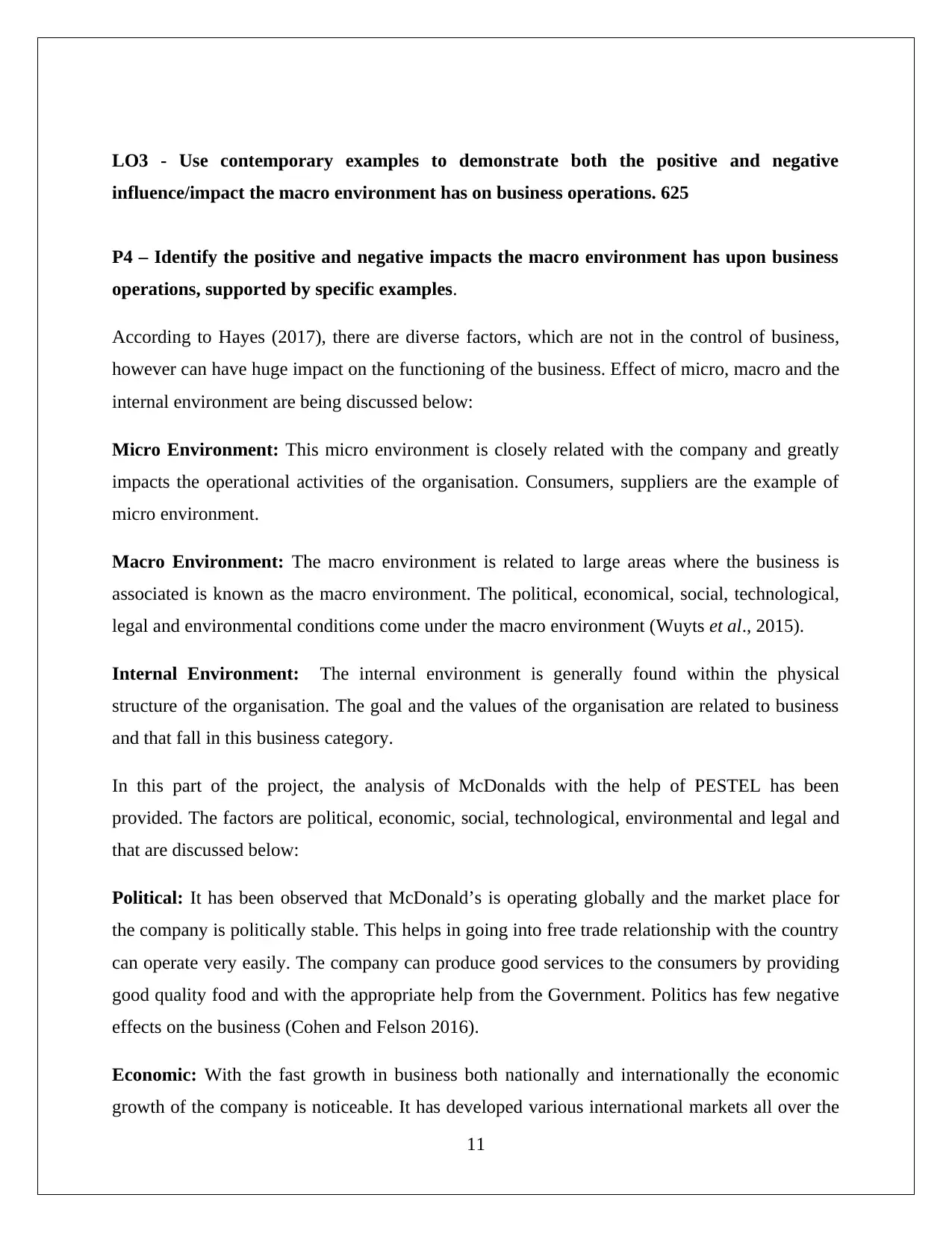
LO3 - Use contemporary examples to demonstrate both the positive and negative
influence/impact the macro environment has on business operations. 625
P4 – Identify the positive and negative impacts the macro environment has upon business
operations, supported by specific examples.
According to Hayes (2017), there are diverse factors, which are not in the control of business,
however can have huge impact on the functioning of the business. Effect of micro, macro and the
internal environment are being discussed below:
Micro Environment: This micro environment is closely related with the company and greatly
impacts the operational activities of the organisation. Consumers, suppliers are the example of
micro environment.
Macro Environment: The macro environment is related to large areas where the business is
associated is known as the macro environment. The political, economical, social, technological,
legal and environmental conditions come under the macro environment (Wuyts et al., 2015).
Internal Environment: The internal environment is generally found within the physical
structure of the organisation. The goal and the values of the organisation are related to business
and that fall in this business category.
In this part of the project, the analysis of McDonalds with the help of PESTEL has been
provided. The factors are political, economic, social, technological, environmental and legal and
that are discussed below:
Political: It has been observed that McDonald’s is operating globally and the market place for
the company is politically stable. This helps in going into free trade relationship with the country
can operate very easily. The company can produce good services to the consumers by providing
good quality food and with the appropriate help from the Government. Politics has few negative
effects on the business (Cohen and Felson 2016).
Economic: With the fast growth in business both nationally and internationally the economic
growth of the company is noticeable. It has developed various international markets all over the
11
influence/impact the macro environment has on business operations. 625
P4 – Identify the positive and negative impacts the macro environment has upon business
operations, supported by specific examples.
According to Hayes (2017), there are diverse factors, which are not in the control of business,
however can have huge impact on the functioning of the business. Effect of micro, macro and the
internal environment are being discussed below:
Micro Environment: This micro environment is closely related with the company and greatly
impacts the operational activities of the organisation. Consumers, suppliers are the example of
micro environment.
Macro Environment: The macro environment is related to large areas where the business is
associated is known as the macro environment. The political, economical, social, technological,
legal and environmental conditions come under the macro environment (Wuyts et al., 2015).
Internal Environment: The internal environment is generally found within the physical
structure of the organisation. The goal and the values of the organisation are related to business
and that fall in this business category.
In this part of the project, the analysis of McDonalds with the help of PESTEL has been
provided. The factors are political, economic, social, technological, environmental and legal and
that are discussed below:
Political: It has been observed that McDonald’s is operating globally and the market place for
the company is politically stable. This helps in going into free trade relationship with the country
can operate very easily. The company can produce good services to the consumers by providing
good quality food and with the appropriate help from the Government. Politics has few negative
effects on the business (Cohen and Felson 2016).
Economic: With the fast growth in business both nationally and internationally the economic
growth of the company is noticeable. It has developed various international markets all over the
11
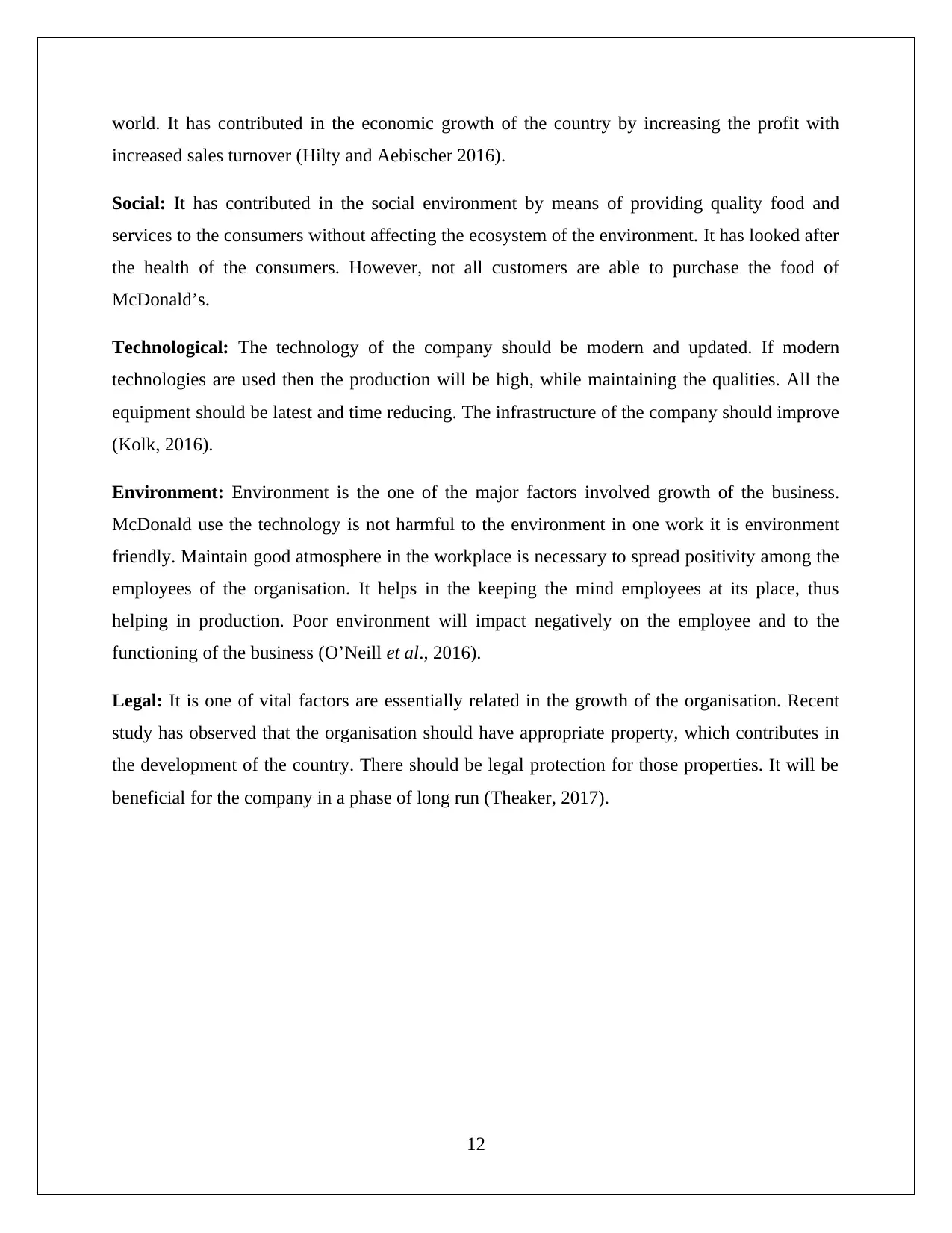
world. It has contributed in the economic growth of the country by increasing the profit with
increased sales turnover (Hilty and Aebischer 2016).
Social: It has contributed in the social environment by means of providing quality food and
services to the consumers without affecting the ecosystem of the environment. It has looked after
the health of the consumers. However, not all customers are able to purchase the food of
McDonald’s.
Technological: The technology of the company should be modern and updated. If modern
technologies are used then the production will be high, while maintaining the qualities. All the
equipment should be latest and time reducing. The infrastructure of the company should improve
(Kolk, 2016).
Environment: Environment is the one of the major factors involved growth of the business.
McDonald use the technology is not harmful to the environment in one work it is environment
friendly. Maintain good atmosphere in the workplace is necessary to spread positivity among the
employees of the organisation. It helps in the keeping the mind employees at its place, thus
helping in production. Poor environment will impact negatively on the employee and to the
functioning of the business (O’Neill et al., 2016).
Legal: It is one of vital factors are essentially related in the growth of the organisation. Recent
study has observed that the organisation should have appropriate property, which contributes in
the development of the country. There should be legal protection for those properties. It will be
beneficial for the company in a phase of long run (Theaker, 2017).
12
increased sales turnover (Hilty and Aebischer 2016).
Social: It has contributed in the social environment by means of providing quality food and
services to the consumers without affecting the ecosystem of the environment. It has looked after
the health of the consumers. However, not all customers are able to purchase the food of
McDonald’s.
Technological: The technology of the company should be modern and updated. If modern
technologies are used then the production will be high, while maintaining the qualities. All the
equipment should be latest and time reducing. The infrastructure of the company should improve
(Kolk, 2016).
Environment: Environment is the one of the major factors involved growth of the business.
McDonald use the technology is not harmful to the environment in one work it is environment
friendly. Maintain good atmosphere in the workplace is necessary to spread positivity among the
employees of the organisation. It helps in the keeping the mind employees at its place, thus
helping in production. Poor environment will impact negatively on the employee and to the
functioning of the business (O’Neill et al., 2016).
Legal: It is one of vital factors are essentially related in the growth of the organisation. Recent
study has observed that the organisation should have appropriate property, which contributes in
the development of the country. There should be legal protection for those properties. It will be
beneficial for the company in a phase of long run (Theaker, 2017).
12
⊘ This is a preview!⊘
Do you want full access?
Subscribe today to unlock all pages.

Trusted by 1+ million students worldwide
1 out of 19
Related Documents
Your All-in-One AI-Powered Toolkit for Academic Success.
+13062052269
info@desklib.com
Available 24*7 on WhatsApp / Email
![[object Object]](/_next/static/media/star-bottom.7253800d.svg)
Unlock your academic potential
Copyright © 2020–2025 A2Z Services. All Rights Reserved. Developed and managed by ZUCOL.




